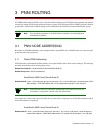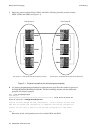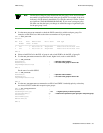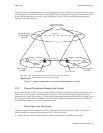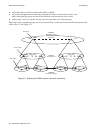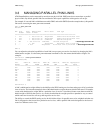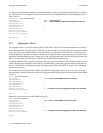
SmartSwitch ATM User Guide 3-3
PNNI Routing Multi-level PNNI Topology
Use the show pnninode command to view ATM SmartSwitch PNNI node parameters. For example:
SmartSwitch # show pnninode
NodeIndex(1) :
================================================================================
Node Index : 1
Node Level : 80
Node Id : 50:a0:39:00:00:00:00:00:00:00:00:00:83:91:e5:00:20:d4:29:0e:ff:00
Lowest : True
Admin Status : Up
Oper Status : Up
Node ATM Addr: 39:00:00:00:00:00:00:00:00:00:83:91:e5:00:20:d4:29:0e:ff:00
Peer Group Id: 50:39:00:00:00:00:00:00:00:00:00:00:00:00
Rst Transit : False
Complex Rep : False
Rst Branching: False
DB Overload : False
Ptse : 2
SmartSwitch #
Note Keep in mind that the Node ATM Address is not the same as the ATM address of
the switch client (if any). The
Node ATM Address is used by PNNI to identify
PNNI nodes and does not correspond to LANE entities.
3.2 MULTI-LEVEL PNNI TOPOLOGY
Having all ATM switches on your network in the same peer group is a simple way of assuring connectivity between
all nodes. However, depending on the size and complexity of your network, there are advantages to dividing your
PNNI network into different peer groups and levels. The basic steps for creating multiple peer groups and multiple
levels are as follows:
• Set the peer group IDs of ATM SmartSwitches to differentiate their peer group membership.
• Select one (or more) ATM SmartSwitch within each peer group as the Peer Group Leader (PGL).
• Add a higher-level PNNI node to each PGL switch. This higher-level node represents its peer group
as a Logical Group Node (LGN) within the next highest (parent) peer group. Connectivity between
the peer groups is established within the parent peer group.
• Communicate the PGL’s existence to the rest of the peer group by setting its leadership priority.
• Physically connect the two peer groups.
3.2.1 Connecting Multiple Peer Groups
This section presents a practical, step-by-step example of creating a multi-level, multiple peer group topology. The
example is based on the following components and organization (see Figure 3-1).
• Six ATM SmartSwitches divided into two peer groups:
- Three ATM SmartSwitches in peer group A (switches SWA1, SWA2, and SWA3)
- Three ATM SmartSwitches in peer group B (switches SWB1, SWB2, and SWB3)









